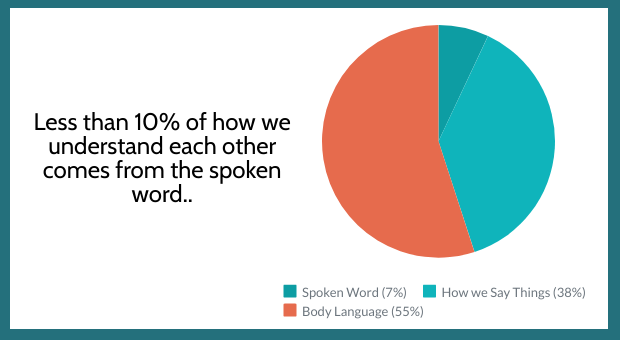Training South West Blog
Using Body Language to Boost your Outcomes
Did you know that less than 10% of how we understand each other, comes from the words we speak?
The other 90% comes from nonverbal factors such as posture, intonation, microexpressions, facial expressions, hand gestures, intonation, and eye contact. Usually, we're not even aware that we are using or decoding them. It's so ingrained in us, that we do so subconsciously.
Definition of Body Language:
Body language can be defined as the use of the body to communicate. This may include facial expressions, micro-expressions, hand gestures and body movements. Some of these behaviours, such as shaking the head, are obvious and easy to decode, whilst others are more subtle. Although someone might pick up on them subconsciously and without much effort, it is also the case that interpreting them may take considerable effort.
1. The power of what isn't said
Influential work by communications pioneer, Professor Mehrabian cites that:
- 7% of meaning is derived from the spoken word
- 38% of meaning is derived from intonation and the way we say things and;
- 55% of meaning is derived from our body language and facial expressions
It's important to acknowledge that non-spoken communication can be a lot more powerful than our spoken communication.
2. Body Language Scenarios
So why is our body language and non-verbal communication so important? Let's explore some scenarios:
Scenario 1 - You visit one of your colleagues to discuss something and they frequently glance at their computer screen or look at their watch. Acknowledging these cues, you perceive that they are not fully engaged in what you're saying or that they don't consider the topic to be as important as you do.
Scenario 2 - You invite someone to discuss something with you. They sit down, look you in the eye, lean forwards a little, and put their phone down. These behaviours lead you to perceive that they are engaged and interested in what you have to say and that they consider the topic worthy of their time.
Scenario 3 - In our final scenario, the person you're speaking to sits further back in his seat during your exchange. He then folds his arms in front of him, furrows his forehead a little, and reduces eye contact with you. When you ask if he's comfortable with what you're saying, he tells you in a raised tone that he is. What do you believe? The words he's just spoken to you, or his body language?
Although simple, these scenarios clearly illustrate the power of unspoken language. Recognising their influence is an important part of improving our communication skills. It also plays an essential role when communicating during difficult conversations.
3. Examples of Common Body Language Behaviours
Below, are some of the more common behaviours:
Fidgeting – Fidgeting can suggest that someone is nervous or uncomfortable with a conversation.
Change in intonation – A switch in intonation suggests that someone's approval of what is being discussed has changed.
Body posture – Slouching can indicate that someone lacks confidence, that they are not engaged or that they feel inhibited. Likewise, good posture conveys engagement, interest and confidence.
Head tilt – A head tilted to the side suggests that the other person is interested and processing what they have been told.
Flared Nostrils – Flared nostrils indicate possible anger or irritation.
Blinking – Increased blinking may suggest that the person is stressed.
Jaws to the side – Moving one's jaws to the side suggests distress, contempt or dislike.
Arm position – Whilst arms folded in front of someone indicate possible discomfort or defensiveness, arms positioned behind the back suggest that someone sees themselves as superior or that they are trying to create distance.
Understanding the context and interpreting behaviours in light of this, however, is essential. For example, fidgeting may also mean that someone's late or that they need the bathroom! Or arms folded in front of someone may mean that they are simply cold. Interpreting everything against the broader contextual backdrop is a must.
4. Using Body Language as a Tool
An important part of building trust when communicating it that our body language must match what we say. Any incongruence between what we say and our body language will lose the trust of the people we are speaking to. For example, saying we're happy about plans through clenched teeth will create obvious distrust.
Direct or webinar communication should always be given over email or telephone when communicating at work as this will enable you to reinforce your messages and decode and respond to the cues given off by the person you're communicating with. Avoid emailing the person sitting next to you or someone who happens to sit 10 metres across the room.
Look for cues and work with them. For example, if a person is giving off any negative cues, then ask them an open question such as, 'What do you feel about that? Does it work for you or do you think there might be a better way?'
Although it might sound bizarre, it's also a good idea to think about your body language when you're on the phone. For example, research shows that smiling is transmitted through our vocal patterns.If smiling on the phone, then our smiles can be perceived which provides an added boost for relationship building and trust. It's also an emotional contagion. If we are positive, we're more likely to lift the mood of the person we're speaking to.
So use this blog as a starting point and make a conscious effort to be mindful of your body language and that of others. Use your body language as a tool to try and boost your outcomes.
5. Communication Skills Training
Not only do we run communications training courses for Southwest businesses, but we also run training for staff who are required to manage difficult conversations. Our 'Managing Difficult Conversations' training courses are a fantastic way to help staff harness their communication skills effectively when dealing with difficult customers or conversations.
Contact the Training South West team for more information.
Blog image by G. Malhotra




